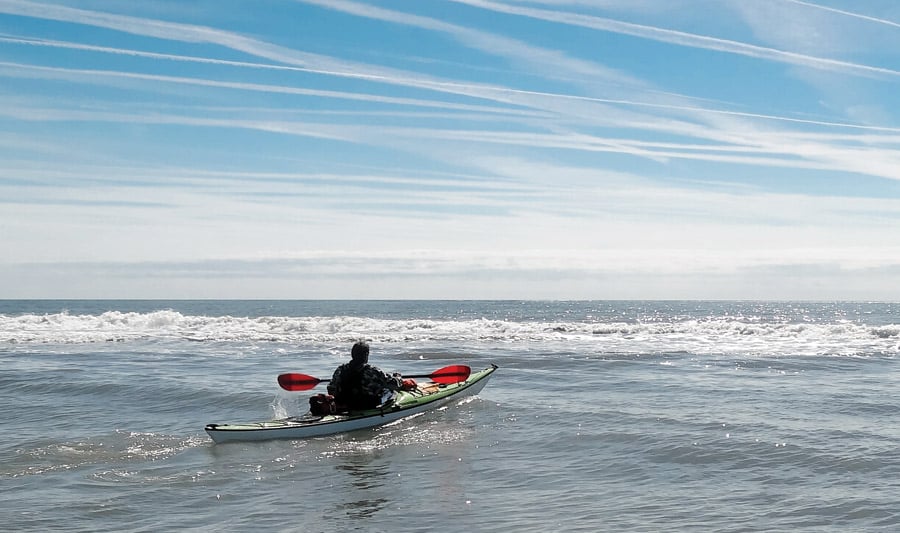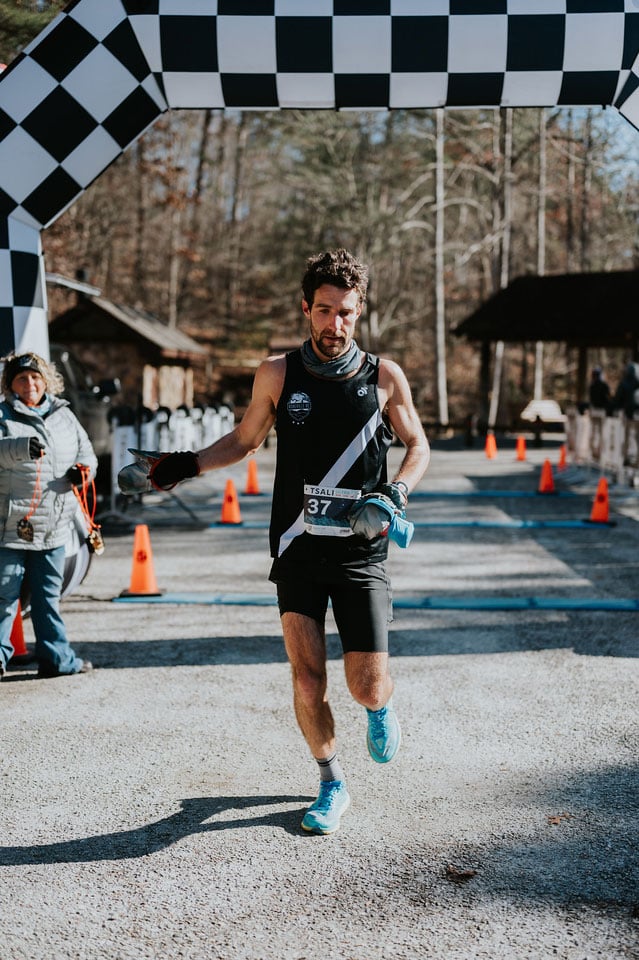Jordan grabbed his cell phone from the console of my pick-up.
“Really? You’re bringing your iPhone?” I raised my eyebrows. Part of the appeal of paddling the unspoiled Georgia coast was leaving my smartphone behind. “GPS might come in handy,” he said.
Over the three-day weekend, we planned to paddle fifty miles from Tybee Island to Sapelo Island on the ocean. After we rounded the southern point of Sapelo, we’d follow meandering saltwater marshes for the last twelve miles to Darien, a small fishing town where I’d left my truck.
We started paddling into the late afternoon sun. I looked down to make sure I’d secured the waterproof chart of the Georgia coastline under my deck lines.
The map secured, I sighed with contentment. The combination of the waves lapping at the hull of my kayak and the smell of saltwater reminded me of the years I’d guided sea kayak tours along California’s rugged coastline. Living in the mountains, I missed ocean paddling. So when I heard about the string of barrier islands off Georgia’s coast, I started looking for a partner.
Jordan seemed ideal for the trip – he was comfortable in the wilderness, having led troubled youth on backpacking trips for years. He’d also cultivated the patience and determination for endurance sports, competing in tough multi-sport races.
We paddled hard to make up for our late start, passing by the golden beaches of Little Tybee Island in silence. We made an open water crossing toward the next island just as the sunset transformed the small waves into shimmering pink light. Shades of pastel pink danced on the water, leaping playfully from one wave to the next. My paddling slowed as I watched the sky melt seamlessly into the ocean. The setting sun seemed to have an opposite effect on Jordan. He raced toward the beach so he could pitch the tent in the evening’s last light. That night we slept to the lullaby of crashing waves.
The next morning I unzipped the tent door as the first hint of yellow graced the gray dawn. Eager to figure out how far we’d paddled the day before, I searched my kayak for the map. But the map wasn’t on my deck. I emptied every dry bag and searched Jordan’s boat. The map was gone.
When I told Jordan, he smiled. “An adventure doesn’t begin until something goes wrong.”
We spent Saturday paddling in choppy conditions, fighting to keep our boats straight, as swells from different directions constantly changed the angle of our bows. Just as the sunset gilded the ocean golden, we carried our kayaks across a beach strewn with driftwood. Georgia’s coast experiences the highest tidal range of any southeastern shoreline and we’d landed at peak of low tide, giving us a long walk across the white sand with fully loaded boats. My arms, already sore from the day’s paddle, buckled under the strain, and I had to ask for several breaks to shake off the fatigue.
After setting up camp, Jordan pulled a satellite map up on his iPhone – his battery was nearly dead so he used his waterproof camera to take a picture of the satellite map while he still could. At least we’d have something to go by the next day as we tried to navigate our way back to the truck.
That night I tossed and turned, worrying about whether we’d make it back to Darien by the next evening. I had the usual Monday obligations – a writing deadline to meet before picking up my toddler from daycare.
Sunday morning we started paddling shortly after sunrise. The island we camped on that night seemed to stretch forever as we paddled past strands of live oak. Blisters covered my hands, and I showed them to Jordan. “Do you have any?”
“Ky, I’m a working man. Hard men have hard hands.”
I rolled my eyes and dug deep to paddle ahead of him.
An hour later dense gray clouds replaced the sunny blue skies, making it impossible to tell the time. Slow steady showers made the world around us as wet as the sea under us. The ocean mirrored the drab sky. Fog transformed the air around us into walls of gray. We paddled into all that gray for minutes that blended into hours, until finally Jordan pointed to a wooden structure on the shore and asked to take a break.
Huddled under the pavilion, we studied the picture of the map on his camera. But with the contours of the island cloaked in grey, we had no idea where exactly on Sapelo Island we were or how much farther we had to paddle until we made our last crossing toward the salt marshes.
“We’re lost!” I shook my head in despair.
“Easy, killer, we’re not lost. We just don’t know exactly where we are.”
We ate the last of our bars. Between us, we still had half a bar of chocolate, almonds, and dried mangos.
I thought about my son – we had to at least make it back to the truck that night, even if we paddled by the light of our headlamps. “Let’s keep paddling,” I said.
We paddled another hour against the outgoing tide until we spotted the far end of the last open water crossing. The tide rushed out against the incoming waves, creating standing waves that crested in white peaks from all directions. Jordan shouted encouragements at me. I grunted with effort as I stabbed my paddle into each peak and tried to pull my kayak forward. But the current was stronger than me. The sky darkened as night approached.
“We’re camping for the night,” Jordan finally said.
Dense columns of rain poured from the dark sky as we zipped the rain fly. I crawled into my damp sleeping bag and pulled it over my head, shivering as I tried to get warm. We went to bed that night without eating dinner. At the first sign of dawn on Monday morning, we started paddling across the open water crossing, scanning the shoreline for an opening in the cord grass. We finally found it, and entered into a twisting, turning maze of tidal creeks. We came to a split and had to decide between turning left or right.
Jordan studied his camera, trying to make sense of the photograph he’d taken of the map. I looked to the right and saw the same choppy conditions, and I figured that way led back out to the ocean. I looked left and saw the green and red markings of a boating channel. I recited the ditty I learned in my youth spent sailing the Chesapeake Bay, “Red right on return.” The piling topped with red sat on the right of the channel, which meant it led back to a harbor.
“I vote left,” I said.
Jordan spent another fifteen minutes studying the image of the map on his waterproof camera, while I bit my tongue. He finally picked up his paddle, and I followed a couple of boat-lengths behind him. When he turned left, I sighed with relief.
A few miles later, a dolphin popped up next to my paddle. Her head was so close I could have reached out and touched it. The dolphin seemed to be smiling up at me. I shouted excitedly to Jordan, but he didn’t return my smile.
“I can’t talk about dolphins right now.” His voice flat, he stared straight ahead.
“Do you hate me?”
“I don’t hate you. I just can’t talk to you. I’m focused on getting us back to the truck before dark and we’re losing ground.” He sped off in front.
We paddled on, me smiling at the dolphin and him staring down at his camera and compass.
We zigged and zagged through the labyrinthine marsh. Finally, the dock came into view from behind a curtain of cordgrass. We tied the sea kayaks up to a piling.
Jordan smiled at me: “We made it! Aren’t you glad I brought my phone?”
I hugged him. “Best decision ever.”









